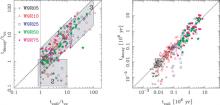
Abstract
We study the circumstances under which first collisions occur in young and dense star clusters. The initial conditions for our direct N-body simulations are chosen such that the clusters experience core collapse within a few million years, before the most massive stars have left the main-sequence. It turns out that the first collision is typically driven by the most massive stars in the cluster. Upon arrival in the cluster core, by dynamical friction, massive stars tend to form binaries. The enhanced cross section of the binary compared to a single star causes other stars to engage the binary. A collision between one of the binary components and the incoming third star is then mediated by the encounters between the binary and other cluster members. Due to the geometry of the binary-single star engagement the relative velocity at the moment of impact is substantially different than in a two-body encounter. This may have profound consequences for the further evolution of the collision product.